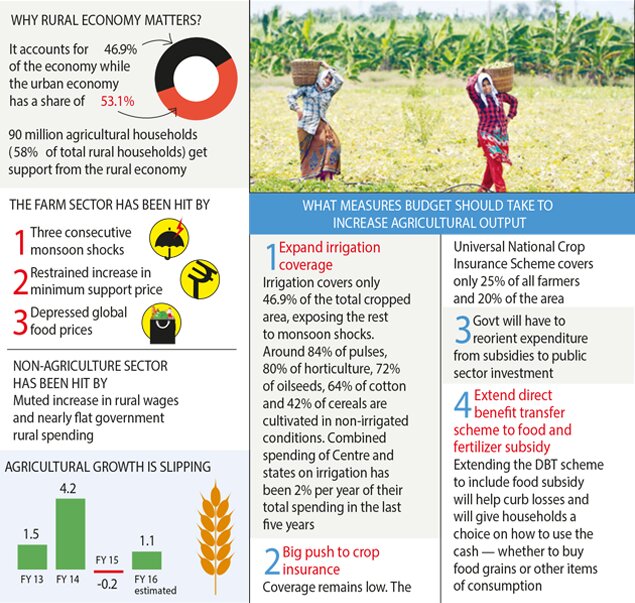Rural Non-Farm Sector | 18 Nov 2020
This article is based on “Spot the seeds of growth” which was published in The Indian Express on 18/11/2020. It talks about the importance & challenges of the rural non-farm sector in India.
Due to the economic downturn caused by Covid-19 pandemic, India’s GDP contracted by 23.9 %. in the first quarter. However, a silver lining in this degrowth scenario can be noted as agriculture grew by 3.4%.
Despite green shoots, agriculture in India is ailing for a long time. It has been grappling with issues like fast depleting groundwater, soil degradation, fragmented markets, barely functioning agricultural extension services and speeding up of climate change.
It is due to these factors agriculture cannot overturn contraction in other sectors, but along with the non-farm rural sector, it could jump-start the economy. Apart from this, Non-Farm rural activities (livestock, fisheries and food processing, etc.) are advantageous in lifting the poor above the poverty line.
Therefore, it becomes imperative to identify the issues of the non-farm rural sector in India to focus on building strong growth links between the non-farm rural economy and agriculture.
Importance of Rural Non-Farm Sector
The non-farm sector, particularly in rural areas is being accorded wide recognition in recent years for the following reasons:
- Check on Unregulated Migration: A planned strategy of rural non-farm development may prevent many rural people from migrating to urban industrial and commercial centres.
- Bridging Rural-Urban Divide: When the economic base of the rural economy extends beyond agriculture, rural-urban economic gaps are bound to get narrower along with salutary effects in many other aspects associated with the life and aspirations of the people.
- Employment Generation: Non-farm rural industries are generally less capital-intensive and more labour absorbing. Thus, they can play a critical role in employment growth in rural areas.
- Reducing Inequalities: Rural income distribution is much less unequal in areas where a wide network of non-farm avenues of employment exists.
- As the lower strata of rural societies participate much more intensely in non-farm activities, it helps in increasing social mobility.
Associated Challenges
- Weak Institutional Structure: There are many institutions (KVIC, SIDBI, etc.) which were established for the development of the rural non-farm sector.
- However, these institutions are marred by issues like administrative inefficiency, lack of financial autonomy, overlapping jurisdiction, etc.
- Quality of Manpower: High levels of illiteracy in rural India have hampered the growth of the rural non-farm sector.
- In the rural areas, lack of education leads to labour being stagnant in agriculture or moving to casual work occupations in the non-farm sector, and not to salaried employment with higher wages and benefits.
- Together with a lack of technical skills, there is little incentive for rural firms to invest in technology, leading to low levels of labour productivity in the rural manufacturing sector compared to urban manufacturing.
- Forward and Backward Linkages: The gaps in the integration of the production linkages brought about by low accessibility of market, support service weaknesses and intervention of middlemen have constrained the development of non-farm enterprises in India.
- Apart from this, the most significant bottleneck in generating higher levels of rural non-farm activity in India is the quantity, quality and reliability of infrastructure.
- Although corrective steps are now being taken, increased infrastructure remains the most important priority for the future.
Way Forward
Efforts are needed to identify appropriate and effective institutional vehicles for the development of non-farm sector policy and interventions for creating employment opportunities. In this context, the following policy interventions can be taken by the government.
- China’s TVEs Model: China’s labour-intensive township and village enterprises (TVEs), are often described as the “engine of growth” behind China’s remarkable growth.
- The TVEs are hybrid institutions, generally unusual alliances between entrepreneurs and local government officials (acting in the capacity of "owners" of TVE enterprises).
- In this regard, the role of government is crucial, especially in the provision of necessary infrastructure and other support services.
- Supply Chain Integration: It is also vital to improve the marketing links between the village entrepreneurs and the larger business firms located in the towns/cities.
- Such strategic alliances or partnerships can contribute to the sustainability of small villages and tiny enterprises in rural areas.
- Addressing Structural Issues: Other important considerations that need to be focused on may include human resource development, financial/credit facilities, research and development and women’s participation with a view to making the activities self-sustaining in the changing competitive environment.
Conclusion
The non-farm rural sector is increasingly playing an important role in the development of rural areas of India. Specifically, as agriculture’s contribution to the economy is declining, the non-farm sector will need to become more and more a major provider of employment and income to many people in rural areas.
However, it should be noted that the non-farm rural sector is not a substitute for employment in agriculture but rather as a supplementary measure. Agricultural development is still important and should be pursued as a necessary precondition for inclusive development.
|
Drishti Mains Question The non-farm rural sector can increasingly play an important role in the development of rural areas of India. Discuss. |
This editorial is based on “Threat or treat: on RCEP trade deal” which was published in The Hindu on November 17th, 2020. Now watch this on our Youtube channel.

